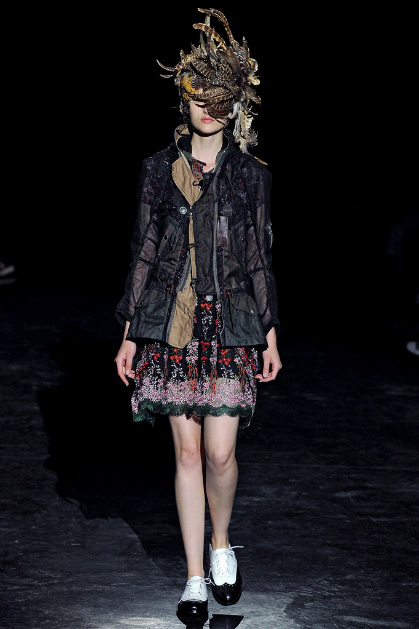






































JNWATNBE S2012RTW fashion runway show reviews
www.junyawatanabe.comParisFashion WeekFashion Brand
JNWATNBE S2012RTW fashion runway show reviews
It pays to have a human encyclopedia at your elbow to help in decoding a Junya Watanabe presentation. When Gene Krell, Vogue Japan's seasoned fashion director, identified today's soundtrack as Beny Moré, the legendary Cuban singer, that was one more clue in Junya's Latin American puzzle. The real giveaway, though, had to be the designer's beloved Perfecto reconfigured as a pale blue leather bolero with ruffled sleeves fit for a mambo king.
The bolero arrived on the heels of a series of light, graceful dresses that looked cut from the lace tablecloth you might find in the homestead where the mambo king lived with his queen. It was easy to imagine the lace being laboriously over-embroidered by women who were perpetuating a craft learned from their mothers, who'd learned it from their mothers, and so on through time. And it was equally easy to imagine Junya being drawn to such a notion. He usually starts somewhere very traditional before he makes his own hybrid adjustments. That happened here when the lace dresses began to grow asymmetric panels of black, or when what looked like spectral military outerwear put in an appearance (a black tulle flight jacket?). The bolero reappeared as a truncated trenchcoat. Then the trenchcoat reappeared as a coat/dress/cape hybrid whose elegant precision gave the effect of wings folded around the model.
It was again thanks to Mr. Krell that the spectator shoes could be placed in the big picture. Dancers of the style of Cuban salsa known as casino wore them. By extension, Kamo's spectacular headgear, composed of rooster feathers, could be construed as some kind of reference to Latin dandy cocks of the walk. But ultimately, all that information was brainiac window dressing. What counted were the clothes themselves—romantic, intriguing, pretty, playful, and ever so slightly subversive in the Watanabe way.